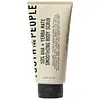What's inside
What's inside
 Key Ingredients
Key Ingredients

 Benefits
Benefits

 Concerns
Concerns

 Ingredients Side-by-side
Ingredients Side-by-side

Glycerin
HumectantWater
Skin ConditioningSodium Laureth Sulfate
CleansingBambusa Vulgaris Extract
Skin ConditioningNacre Powder
AbrasivePrunus Amygdalus Dulcis Oil
Skin ConditioningPropylene Glycol
HumectantBertholletia Excelsa Seed Oil
EmollientButyrospermum Parkii Butter
Skin ConditioningStearic Acid
CleansingArgania Spinosa Kernel Oil
EmollientButter
Skin ConditioningLavandula Angustifolia Oil
MaskingVaccinium Angustifolium Fruit Juice
AstringentCitric Acid
BufferingTheobroma Cacao Seed Butter
EmollientChondrus Crispus Extract
Skin ConditioningTitanium Dioxide
Cosmetic ColorantTalc
AbrasiveTriethanolamine
BufferingCetearyl Alcohol
EmollientSynthetic Fluorphlogopite
Tin Oxide
AbrasiveCoumarin
PerfumingGeraniol
PerfumingLimonene
PerfumingLinalool
PerfumingCI 77491
Cosmetic ColorantCI 45410
Cosmetic ColorantCI 77499
Cosmetic ColorantGlycerin, Water, Sodium Laureth Sulfate, Bambusa Vulgaris Extract, Nacre Powder, Prunus Amygdalus Dulcis Oil, Propylene Glycol, Bertholletia Excelsa Seed Oil, Butyrospermum Parkii Butter, Stearic Acid, Argania Spinosa Kernel Oil, Butter, Lavandula Angustifolia Oil, Vaccinium Angustifolium Fruit Juice, Citric Acid, Theobroma Cacao Seed Butter, Chondrus Crispus Extract, Titanium Dioxide, Talc, Triethanolamine, Cetearyl Alcohol, Synthetic Fluorphlogopite, Tin Oxide, Coumarin, Geraniol, Limonene, Linalool, CI 77491, CI 45410, CI 77499
Water
Skin ConditioningPerlite
AbsorbentLactic Acid
BufferingGlycerin
HumectantSodium Hydroxide
BufferingSodium Cocoyl Isethionate
CleansingStearyl Alcohol
EmollientSimmondsia Chinensis Seed Oil
EmollientPropanediol
SolventGlyceryl Stearate
EmollientMandelic Acid
AntimicrobialCeteareth-20
CleansingGlycolic Acid
BufferingOlea Europaea Seed Powder
AbrasiveGluconolactone
Skin ConditioningTridecyl Trimellitate
EmollientHylocereus Undatus Fruit Extract
Skin ConditioningIlex Guayusa Leaf Extract
Skin ProtectingIlex Paraguariensis Leaf Extract
PerfumingPassiflora Edulis Fruit Extract
Skin ConditioningBisabolol
MaskingCaffeine
Skin ConditioningTrisodium Ethylenediamine Disuccinate
Hydrogenated Castor Oil
EmollientHydrogenated Jojoba Oil
AbrasiveCaprylyl Glycol
EmollientCitric Acid
BufferingCoconut Acid
CleansingIsohexadecane
EmollientPolysorbate 80
EmulsifyingSodium Acrylate/Sodium Acryloyldimethyl Taurate Copolymer
Emulsion StabilisingSodium Isethionate
CleansingSorbitan Oleate
EmulsifyingXanthan Gum
EmulsifyingLimonene
PerfumingLinalool
PerfumingPhenoxyethanol
PreservativePotassium Sorbate
PreservativeSodium Benzoate
MaskingParfum
MaskingWater, Perlite, Lactic Acid, Glycerin, Sodium Hydroxide, Sodium Cocoyl Isethionate, Stearyl Alcohol, Simmondsia Chinensis Seed Oil, Propanediol, Glyceryl Stearate, Mandelic Acid, Ceteareth-20, Glycolic Acid, Olea Europaea Seed Powder, Gluconolactone, Tridecyl Trimellitate, Hylocereus Undatus Fruit Extract, Ilex Guayusa Leaf Extract, Ilex Paraguariensis Leaf Extract, Passiflora Edulis Fruit Extract, Bisabolol, Caffeine, Trisodium Ethylenediamine Disuccinate, Hydrogenated Castor Oil, Hydrogenated Jojoba Oil, Caprylyl Glycol, Citric Acid, Coconut Acid, Isohexadecane, Polysorbate 80, Sodium Acrylate/Sodium Acryloyldimethyl Taurate Copolymer, Sodium Isethionate, Sorbitan Oleate, Xanthan Gum, Limonene, Linalool, Phenoxyethanol, Potassium Sorbate, Sodium Benzoate, Parfum
Ingredients Explained
These ingredients are found in both products.
Ingredients higher up in an ingredient list are typically present in a larger amount.
Citric Acid is an alpha hydroxy acid (AHA) naturally found in citrus fruits like oranges, lemons, and limes.
Like other AHAs, citric acid can exfoliate skin by breaking down the bonds that hold dead skin cells together. This helps reveal smoother and brighter skin underneath.
However, this exfoliating effect only happens at high concentrations (20%) which can be hard to find in cosmetic products.
Due to this, citric acid is usually included in small amounts as a pH adjuster. This helps keep products slightly more acidic and compatible with skin's natural pH.
In skincare formulas, citric acid can:
While it can provide some skin benefits, research shows lactic acid and glycolic acid are generally more effective and less irritating exfoliants.
Most citric acid used in skincare today is made by fermenting sugars (usually from molasses). This synthetic version is identical to the natural citrus form but easier to stabilize and use in formulations.
Read more about some other popular AHA's here:
Learn more about Citric AcidGlycerin is already naturally found in your skin. It helps moisturize and protect your skin.
A study from 2016 found glycerin to be more effective as a humectant than AHAs and hyaluronic acid.
As a humectant, it helps the skin stay hydrated by pulling moisture to your skin. The low molecular weight of glycerin allows it to pull moisture into the deeper layers of your skin.
Hydrated skin improves your skin barrier; Your skin barrier helps protect against irritants and bacteria.
Glycerin has also been found to have antimicrobial and antiviral properties. Due to these properties, glycerin is often used in wound and burn treatments.
In cosmetics, glycerin is usually derived from plants such as soybean or palm. However, it can also be sourced from animals, such as tallow or animal fat.
This ingredient is organic, colorless, odorless, and non-toxic.
Glycerin is the name for this ingredient in American English. British English uses Glycerol/Glycerine.
Learn more about GlycerinLimonene is a fragrance that adds scent and taste to a formulation.
It's found in the peel oil of citrus fruits and other plants such as lavender and eucalyptus. The scent of limonene is generally described as "sweet citrus".
Limonene acts as an antioxidant, meaning it helps neutralize free radicals.
When exposed to air, oxidized limonene may sensitize the skin. Because of this, limonene is often avoided by people with sensitive skin.
The term 'fragrance' is not regulated in many countries. In many cases, it is up to the brand to define this term. For instance, many brands choose to label themselves as "fragrance-free" because they are not using synthetic fragrances. However, their products may still contain ingredients such as essential oils that are considered a fragrance.
Learn more about LimoneneLinalool is a fragrance and helps add scent to products. It's derived from common plants such as cinnamon, mint, citrus, and lavender.
Like Limonene, this ingredient oxidizes when exposed to air. Oxidized linalool can cause allergies and skin sensitivity.
This ingredient has a scent that is floral, spicy tropical, and citrus-like.
Learn more about LinaloolWater. It's the most common cosmetic ingredient of all. You'll usually see it at the top of ingredient lists, meaning that it makes up the largest part of the product.
So why is it so popular? Water most often acts as a solvent - this means that it helps dissolve other ingredients into the formulation.
You'll also recognize water as that liquid we all need to stay alive. If you see this, drink a glass of water. Stay hydrated!
Learn more about Water